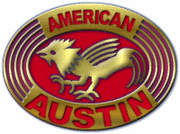.
American Austin Car Company
Search By Model |
| Defunct |
The American Austin Car Company was a United States automobile manufacturing corporation tied to the British Austin Motor Company. The company was founded in 1929, and produced motorcars from 1930 through 1934, when it filed for bankruptcy.
In 1935 the company was reorganized under the name American Bantam. Production resumed in 1937 and continued through 1941, including the first prototype of what later became the Jeep.
American Austin Car Company
The American Austin Car Company was founded in 1929 in Butler, Pennsylvania in order to assemble and sell in the United States a version of the Austin 7 car, called American Austin. After some initial success the Great Depression set in, and sales fell off to the point that production was suspended. In 1934 the company filed for bankruptcy. About 20,000 cars were produced.
American Bantam
In 1935 Roy Evans, a former salesman for Austin, bought out the bankrupt company, which was reorganized under the name American Bantam. 'Bantam' is a smaller-bred version of any particular poultry breed -the name must have been chosen for the size of the automobiles that the company made. All ties to UK Austin were severed. A series of changes was made to the American Austin car design, including a modified engine, and an exterior sheetmetal designed by Alexis de Sakhnoffski. Production was resumed in 1937 and continued through 1941. Despite a wide range of Bantam body styles, ranging from light trucks to a wooden station wagons, only about 6,000 Bantams of all types were produced. American Bantam's 1938 model is famous for being the inspiration for Donald Duck's car.
American Bantam also pioneered the design for the first jeep, called the BRC (Bantam Reconnaissance Car) 40, and built 1,500 of these after discontinuing the manufacture of passenger vehicles. Some of the motors and chasisses were imported from the UK Austin; the bodies were made at the American Austin factories in Detroit, Michigan and Butler, Pennsylvania. However, because the company did not have the production capacity to produce the vehicle on the scale needed by the United States Department of War, the contract was to be determined by a test trial. Eventually the US Army chose a design by Willys-Overland and awarded orders to Willys and Ford, while Bantam went on to produce jeep trailers (T-3).
External links
- AmericanBantam.com
- Austin & Bantam on wmpear.com
- Austin & Bantam on oldmotors.com
- American Austin and American Bantam Photo Galleries at RemarcableCars.com
- American Austin & Bantam Cars and Parts Golden Miles Sales, Inc.

